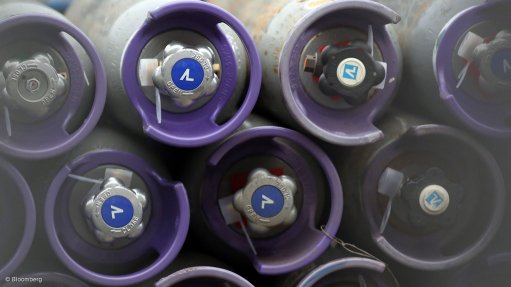Sappi continues turnaround as weak European market persists
Paper and packaging group Sappi continued efforts to reposition itself as a profitable business in a market with lower demand after reporting lower earnings for the year ended September.
Sappi, which fell into the red with a loss of $162-million for the financial year, compared with a profit of $104-million the year before, said its strategy to reposition for growth, higher margins and improved profitability remained on track.
“[This] was an important transitional year for Sappi, with the commissioning of major capital projects and further repositioning of the business,” Sappi CEO Ralph Boëttger said, adding that the major capital expenditure (capex), particularly during the last-half of the year, to bring “massive” projects online, was now behind the group, with debts successfully contained.
Capex of $575-million was incurred in the financial year ended September, mostly owing to dissolving wood pulp conversion projects at the Cloquet mill, in North America, and at the Ngodwana mill, in South Africa, as well as a conversion project at Germany-based Alfeld mill to produce speciality products.
“We expect 2014 will see significantly reduced capex post the completion of the dissolving wood pulp projects and, concomitantly, a reduction in the operational impact that these large capital projects had in the past year,” said Boëttger.
He pointed out that it was likely that the 2014 financial year would likely remain as tough and challenging – perhaps even more so – than the financial year under review, but Sappi was confident of improving its profitability and cash position owing to its restructure.
This comes as Sappi posted a basic loss and headline loss a share of $0.31 and $0.06 respectively for the year ended September, compared with earnings and headline earnings a share of $0.20 and $0.09 respectively in the prior year, as the European markets delivered a worse-than-expected performance against lower paper prices, increased pulp costs and a continued decline in graphic paper demand.
The group’s operating profit fell to $30-million during the year ended September, after reporting an operating profit of $421-million in 2012, with special items amounting to a charge of $161-million, comprising mainly one-off impairment and restructuring charges of $252-million related to both the European and Southern African businesses.
However, profitability was expected to rise in the 2014 financial year, on the back of a larger Specialised Cellulose business, the gradual improvement in performance of the European paper business, an improvement in the profitability of the Southern African paper business and the consistent performance from the North American paper businesses, said Boëttger.
Sappi Fine Paper Europe on Thursday announced that it planned to inject €120-million over the next three years into two coated graphic paper mills, namely the Sappi Gratkorn mill, in Austria, and the Kirkniemi mill, in Finland, to significantly reduce their cost base and improve their profitability.
The group planned to upgrade the pulp production facilities, as well as papermaking capabilities at the one-million-ton-a-year Gratkorn coated woodfree paper mill, while building a new power plant at the Kirkniemi mill to improve cost competitiveness and profitability.
“Despite a tough environment, we are making progress with the necessary transition work identified to strengthen the company and improve our profitability into the future,” said Sappi Fine Paper Europe CEO Berry Wiersum.
Sappi expected a slow recovery in profitability, with the benefits of cost reduction programmes in Europe likely only to emerge during the second half of the financial year, while challenging markets continued to weigh on the paper businesses, where demand for graphic paper in major markets, including Europe and the US, would decline 6% and 3% a year respectively.
The start-up of the newly completed Alfeld PM2 project, which was completed in October – a month into Sappi’s new financial year – would also have a negative impact on the European business’ results in the first financial quarter.
Meanwhile, the group’s Specialised Cellulose business, including the North America-based Cloquet pulp mill, performed “exceptionally well” during the final quarter of the year.
“The combination of increased shipments, favourable exchange rate and production efficiencies resulted in a margin of 39%, which is well above the normalised margin for this business.
“Sales volumes for the [fourth] quarter were 253 000 t, an increase of 36% over the equivalent quarter in the prior year,” said Boëttger, adding that dissolving wood pulp demand was expected to grow at about 6% to 8% a year.
The major Specialised Cellulose conversion projects in South Africa and the US were successfully completed during the year and would contribute to improved revenues and profitability.
“The Southern African Specialised Cellulose business benefited from higher pulp prices, a weaker rand/dollar exchange rate and increased production and shipments. The local graphic paper market remains challenging, with higher paper pulp and other input prices, as well as a competitive import market.
“The domestic paper packaging business is improving, with increased sales volumes and pricing during the quarter and improved operational performance as a result of the actions we have taken in this business,” he explained.
The negative outlook for certain South African paper and packaging segments, with regards to the Tugela, Enstra and Stanger mills, had resulted in impairment charges of $92-million during the year under review.
Sappi noted that “a certain portion” of Southern Africa's softwood plantations that were previously used in the paper pulp production would now be sold to the local sawlog markets, after the Ngodwana mill dissolving wood pulp conversion project and the closure of the Kraft Continuous Digester, at the Tugela mill.
In North America, quarterly operating profit, excluding special items, was lower than for the equivalent quarter last year, owing to a weaker graphic paper market, particularly as regards pricing and dissolving wood pulp production and sales not yet at the full rate for the quarter.
Comments
Press Office
Announcements
What's On
Subscribe to improve your user experience...
Option 1 (equivalent of R125 a month):
Receive a weekly copy of Creamer Media's Engineering News & Mining Weekly magazine
(print copy for those in South Africa and e-magazine for those outside of South Africa)
Receive daily email newsletters
Access to full search results
Access archive of magazine back copies
Access to Projects in Progress
Access to ONE Research Report of your choice in PDF format
Option 2 (equivalent of R375 a month):
All benefits from Option 1
PLUS
Access to Creamer Media's Research Channel Africa for ALL Research Reports, in PDF format, on various industrial and mining sectors
including Electricity; Water; Energy Transition; Hydrogen; Roads, Rail and Ports; Coal; Gold; Platinum; Battery Metals; etc.
Already a subscriber?
Forgotten your password?
Receive weekly copy of Creamer Media's Engineering News & Mining Weekly magazine (print copy for those in South Africa and e-magazine for those outside of South Africa)
➕
Recieve daily email newsletters
➕
Access to full search results
➕
Access archive of magazine back copies
➕
Access to Projects in Progress
➕
Access to ONE Research Report of your choice in PDF format
RESEARCH CHANNEL AFRICA
R4500 (equivalent of R375 a month)
SUBSCRIBEAll benefits from Option 1
➕
Access to Creamer Media's Research Channel Africa for ALL Research Reports on various industrial and mining sectors, in PDF format, including on:
Electricity
➕
Water
➕
Energy Transition
➕
Hydrogen
➕
Roads, Rail and Ports
➕
Coal
➕
Gold
➕
Platinum
➕
Battery Metals
➕
etc.
Receive all benefits from Option 1 or Option 2 delivered to numerous people at your company
➕
Multiple User names and Passwords for simultaneous log-ins
➕
Intranet integration access to all in your organisation





















